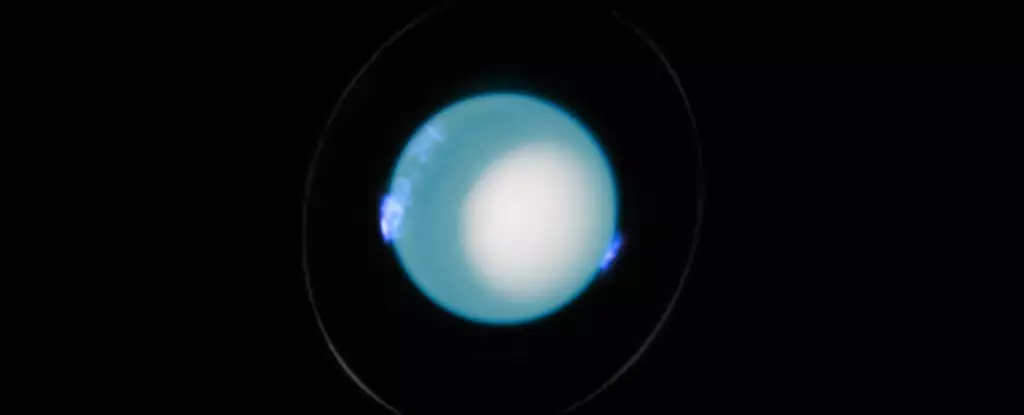In an unexpected twist in planetary science, recent research has redrawn our understanding of Uranus, the seventh planet from the Sun, uncovering its true rotational period. New measurements indicate that a single day on Uranus lasts an astonishing 17 hours, 14 minutes, and 52 seconds. This revelation, which extends the previously estimated day by 28 seconds, marks a significant milestone in our cosmic insights and reignites interest in the study of this distant giant.
Uranus, often overshadowed by its more popular planetary cousins, harbors some of the most peculiar characteristics in the Solar System. Remembered primarily for its striking blue hue and unique sideways rotation, Uranus presents an enticing enigma. The implications of this new finding resonate deeply within the scientific community, as it rectifies previous assumptions derived from Voyager 2’s encounter with the planet in 1986, during which our understanding was based on outdated rotational data.
The Importance of Accurate Measurements
Astrophysicist Laurent Lamy from the Paris Observatory emphasizes the significance of this correction, noting that outdated rotation data had complicated efforts to chart Uranus’ magnetic poles accurately over time. The previous coordinate systems, built upon inaccurate durations of the day’s length, had generated confusion and inaccuracies that hindered our ability to monitor the planet’s features effectively. The newfound accuracy provides not just a numerical adjustment but a pivotal reference point for future observational campaigns aimed at unraveling the complexities of Uranus and its sibling, Neptune.
It’s astonishing to realize just how much confusion an additional 28 seconds can cause in a system as vast and intricate as our Solar System. These discrepancies remind us that even in a realm governed by physics and mathematics, new discoveries can challenge long-held beliefs and push the boundaries of our understanding.
Exploring the Challenges of Outer Planet Research
The distance of Uranus from the Sun complicates its study, rendering both Uranus and Neptune—collectively known as the ice giants—smaller and dimmer than their inner Solar System counterparts. This diminutive appearance brings with it the challenges of limited observational data; only the Voyager missions have ventured close to these enigmatic planets. Such restrictions introduce the risk of biases affecting the information we gather during these fleeting encounters. Without continual study, our knowledge of these distant worlds can quickly become outdated, reflecting conditions that may no longer hold true.
Lamy’s groundbreaking work involved a meticulous analysis of Hubble Space Telescope data collected over a decade, from 2011 to 2022. By observing the ultraviolet auroras of Uranus, similar to Earth’s auroras, Lamy and his team were able to better discern the planet’s rotation. These auroras arise as charged particles from the solar wind interact with the planet’s magnetosphere. The dance of these particles offers critical insights into both Uranus’ magnetic fields and its rotation period, transforming our understanding of such phenomena.
The Unique Axial Tilt of Uranus
Uranus is notorious for its unique axial tilt of approximately 98 degrees—an orientation that causes its magnetic poles to behave erratically compared to other planets. The peculiar tilt contributes to the challenge of mapping the planet accurately, as its rotational and magnetic axes are nearly aligned. Historically, this strange orientation made capturing the precise characteristics of its auroras an uphill battle. Nevertheless, the insights gained from tracking these auroras not only refined our understanding of Uranus’ day length but also highlighted the interconnectedness of its atmospheric and magnetic phenomena.
Lamy’s methodology has broader implications, paving the way for future missions dedicated to studying Uranus. With a refined measurement system at our disposal, researchers are poised to potentially analyze auroral data collected over nearly four decades. This newly established system offers a framework for future explorations, enhancing our understanding of Uranus and refining our approach to studying the remaining giants of our Solar System.
As we ponder the implications of this discovery, we embark on an exciting new chapter in the exploration of our cosmic neighborhood. With technology continually evolving, the potential to uncover more of Uranus’ secrets, and those of its similarly elusive counterpart Neptune, weighs heavily on the horizon of space exploration, beckoning humanity to reach for further knowledge.


Leave a Reply